 Expert's opinion
Expert's opinion
Expert's opinion
The article is a subjective view on this topic written by writers specializing in medical writing.
It may reflect on a personal journey surrounding struggles with an illness or medical condition, involve product comparisons, diet considerations, or other health-related opinions.
Although the view is entirely that of the writer, it is based on academic experiences and scientific research they have conducted; it is fact-checked by a team of degreed medical experts, and validated by sources attached to the article.
The numbers in parenthesis (1,2,3) will take you to clickable links to related scientific papers.
Full Body Workout For Weight Loss: Exercises To Shed Pounds In 2024
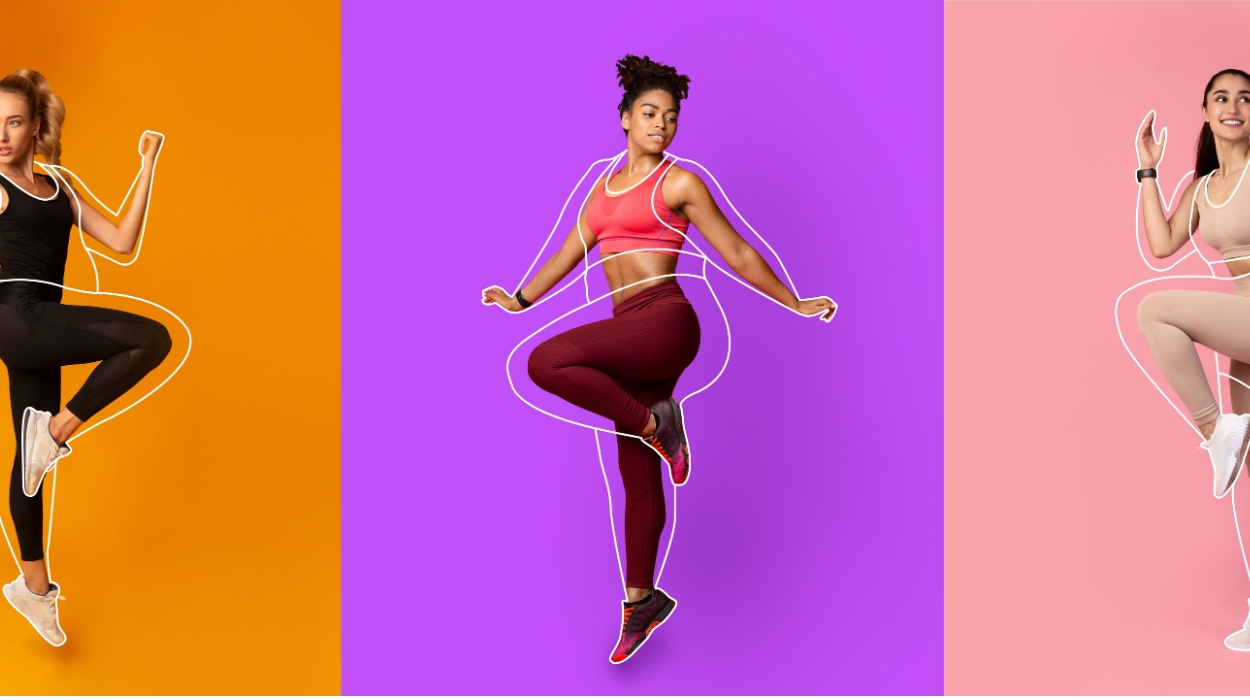
Burning calories depends on the intensity, frequency, and continuity of the exercise and the remaining calorie deficit in your eating habits. This is a fact that has been proven in many scientific studies. However, the type of exercise and the foods that you eat before and after a workout affect your body composition, muscle mass, and fat loss because not every pound that you see change on the scale is fat. You can benefit from activities by diversifying your exercise routine with full body workout for weight loss, high-intensity exercise, endurance, and strength exercises. They can also contribute to weight management.
Best Weight Loss Exercises For Full Body
Full Body Workout For Weight Loss
You can do a full body workout for weight loss at home if you are a beginner because you don’t need any equipment for some of the exercises.
Besides, there are many functional movements with the barbell, dumbbell, and kettlebell for a full-body workout for fat loss. Also, you can vary your exercise routine using weighted balls and rope. You can add the following workouts to lose weight into your exercise routine.
Here are the most effective full body workout to lose weight.
Plank Variations
The plank is a fundamental core-strengthening exercise that can help improve your overall stability and posture.
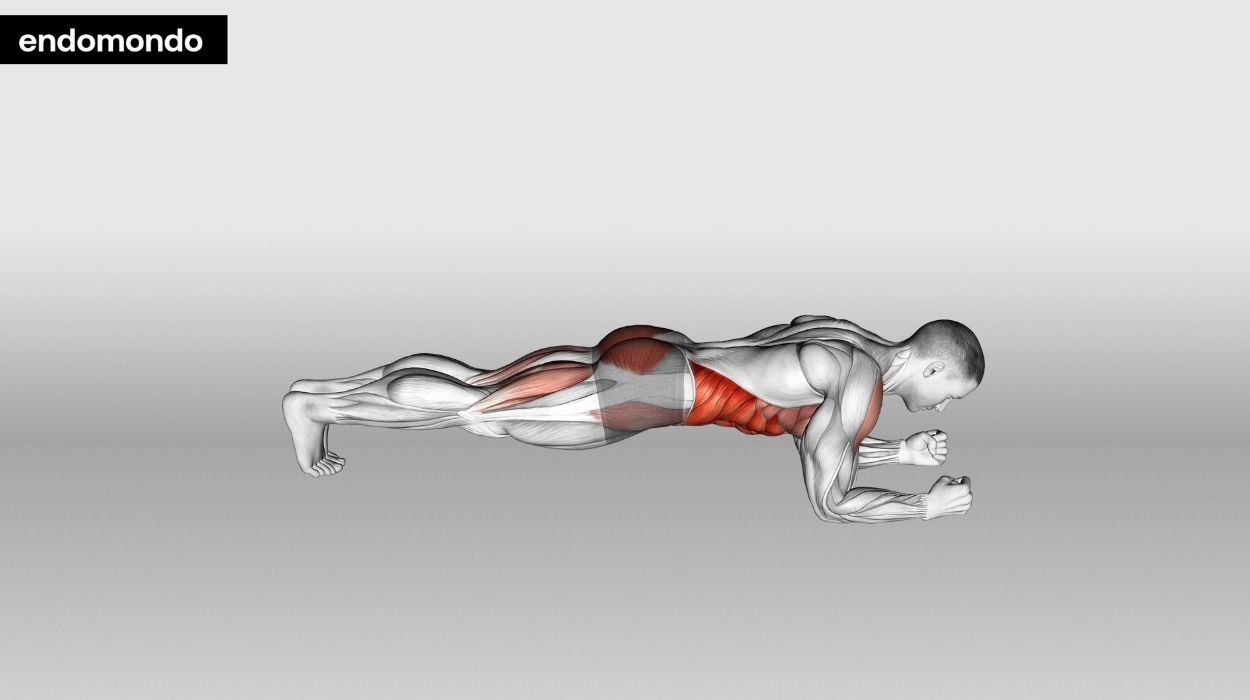
How to do:
- Start in a plank position with forearms on the ground and toes on the floor.
- Hold the plank for a desired amount of time, keeping your core engaged and back flat.
- To perform a side plank, shift your weight onto one forearm and rotate your body, extending the opposite arm towards the ceiling.
- To perform a high plank, start in a push-up position with your hands on the ground, keeping your body in a straight line.
Tips:
- Maintain a straight line from head to heels, engaging your core and glutes to prevent sagging or arching of the lower back.
- Distribute your weight evenly between your forearms or hands and your toes to maintain balance and stability.
- Focus on steady and controlled breathing throughout the plank to enhance endurance and control.
Optimal Sets and Reps: Three to four sets of 20-60 seconds.
Burpees
It is a dynamic, full-body exercise that combines strength, cardio, and agility for a comprehensive workout.

How to do:
- Start in a standing position.
- Lower your body and place your hands on the ground shoulder-width apart.
- Jump your feet back into a high plank position.
- Lower your chest to the ground, then push up with your arms to return to the high plank position.
- Jump your feet back up towards your hands, returning to the squat position.
- You can just stand up, or you can explosively jump.
- Repeat for the desired number of reps.
Tips:
- Maintain a steady breathing pattern throughout the exercise to sustain energy and control.
- Focus on explosive power when jumping back up to improve strength and cardiovascular endurance.
- Warm up adequately before attempting burpees to prepare your muscles and joints for the intensity of the exercise.
Optimal Sets and Reps: Three to four sets of 10-15 reps.
High Knee Running
High knee running is a dynamic cardiovascular exercise that engages your core and lower body while boosting your heart rate for an effective cardio workout.
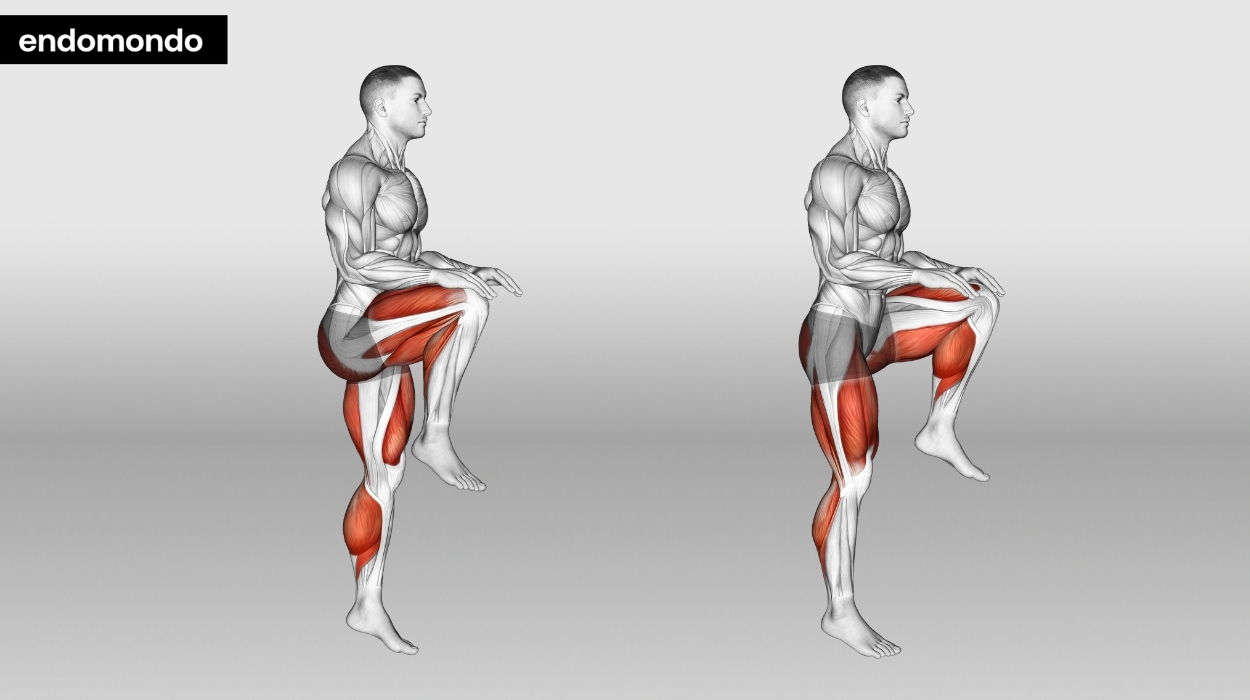
How to do:
- Start by standing with your feet shoulder-width apart.
- Begin running in place, lifting your knees high towards your chest with each stride.
- As you lift your knee, swing your opposite arm forward, then quickly switch and repeat on the other side.
- Maintain a steady rhythm and pace throughout the exercise.
- Keep your core engaged and your posture upright, avoiding leaning forward or backward.
Tips:
- Lift your knees as high as comfortably possible with each step to engage your core and target your hip flexors effectively.
- Maintain an upright posture and avoid leaning backward or forward to reduce strain on your back and maximize the workout’s benefits.
- Focus on a smooth and controlled rhythm, landing softly on the balls of your feet, and maintain a consistent breathing pattern.
Optimal Sets and Reps: Three to five sets of 30-60 seconds.
Mountain Climbing
The mountain climbers are a dynamic, full-body exercise that combines strength, cardio, and core engagement for a powerful workout.
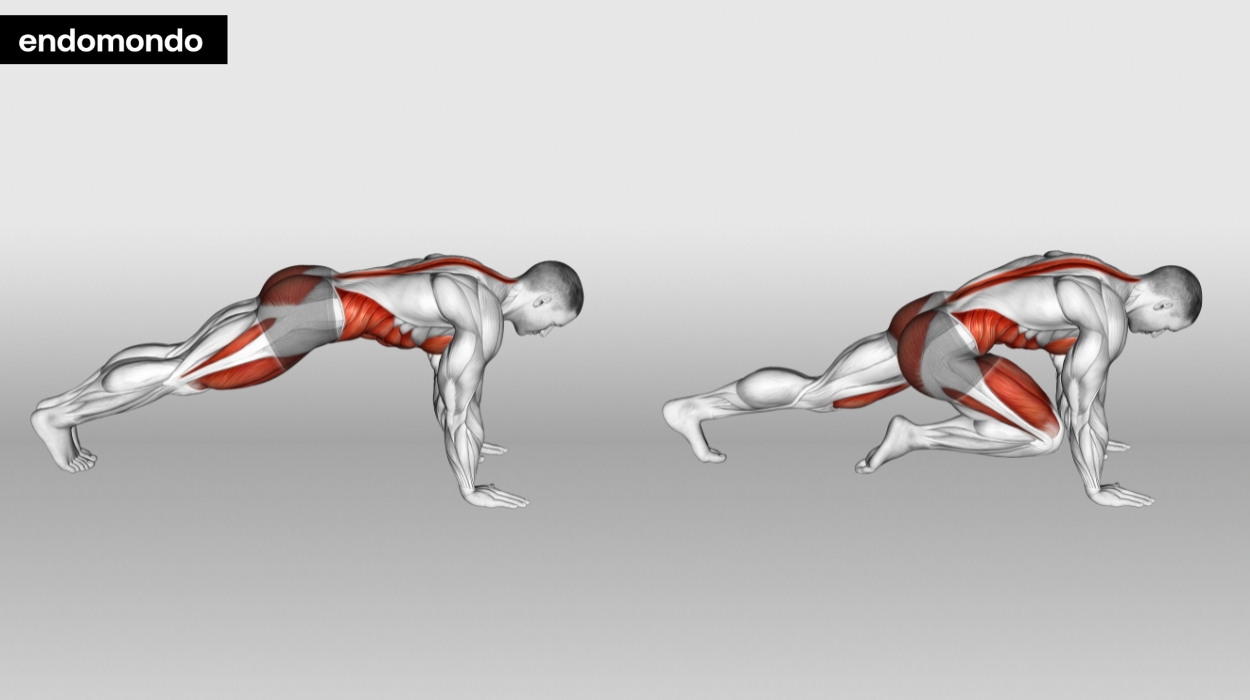
How to do:
- Start in a high plank position, with your hands on the ground and your body in a straight line.
- Lift one foot and bring your knee up towards your chest.
- Quickly switch legs, bringing the other knee up towards your chest while simultaneously extending the opposite leg back.
- Continue alternating legs as quickly as possible, like you’re running in place.
- Keep your core engaged and your hips level throughout the exercise.
Tips:
- Ensure that your hips stay level and do not sag or pike upward during the exercise to work your core effectively.
- Engage your glutes and leg muscles to stabilize your lower body while performing the movement.
- Maintain a consistent and controlled breathing pattern to support endurance and coordination.
Optimal Sets and Reps: Three to four sets of 30-60 seconds.
Tuck Jumps
Tuck jumps are a plyometric exercise that can help improve your explosive power, leg strength, and overall athleticism.
How to do:
- Start in a standing position with feet shoulder-width apart.
- Explosively jump up as high as you can.
- While in the air, tuck your knees up to your chest.
- Quickly release your legs and land softly on your feet.
- Repeat for the desired number of reps, maintaining a consistent rhythm and pace.
- Remember to engage your core and use your leg muscles to generate power for the jump.
Tips:
- Engage your core muscles to maintain stability and control throughout the jump.
- Ensure that your arms play an active role by swinging them upward as you jump and tuck your knees to your chest, assisting in the explosive movement.
- Use proper landing mechanics by allowing your heels to kiss the ground briefly before initiating the next jump to minimize stress on your joints.
Optimal Sets and Reps: Four sets of eight to 10 reps.
Deadlift
The deadlift is one of the most common full-body barbell workouts for fat loss. You can also prefer a deadlift for a full-body dumbbell workout to lose weight. You need one dumbbell for each hand.
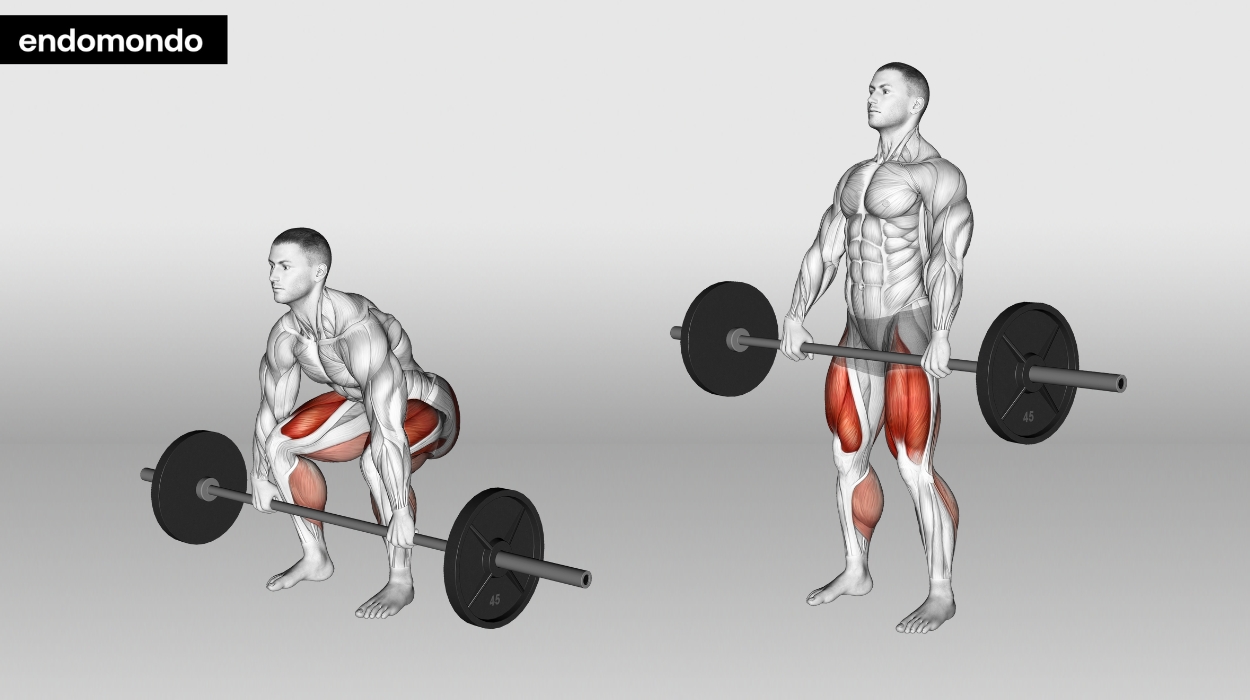
How to do:
- Take your position standing with your midfoot under the barbell
- Bend your knees over to grab the barbell with a shoulder-width grip
- Lift your chest before you lift and straighten your lower back
- Stand up with the weight. It helps you if you take a deep breath and hold it while you are lifting weights.
Tips:
- Maintain a neutral spine throughout the lift by keeping your back straight and avoiding excessive rounding or arching to prevent injury.
- Engage your core muscles and maintain a strong, stable stance with your feet shoulder-width apart for better balance and support.
- Keep the barbell or weights close to your body as you lift; this reduces stress on your lower back and allows for a more efficient lift.
Optimal Sets and Reps: Three sets of 10-12 reps.
Back Squat
The back squat is a fundamental compound exercise that targets your lower body, emphasizing the quadriceps, hamstrings, glutes, and lower back, and is a staple for building leg strength.
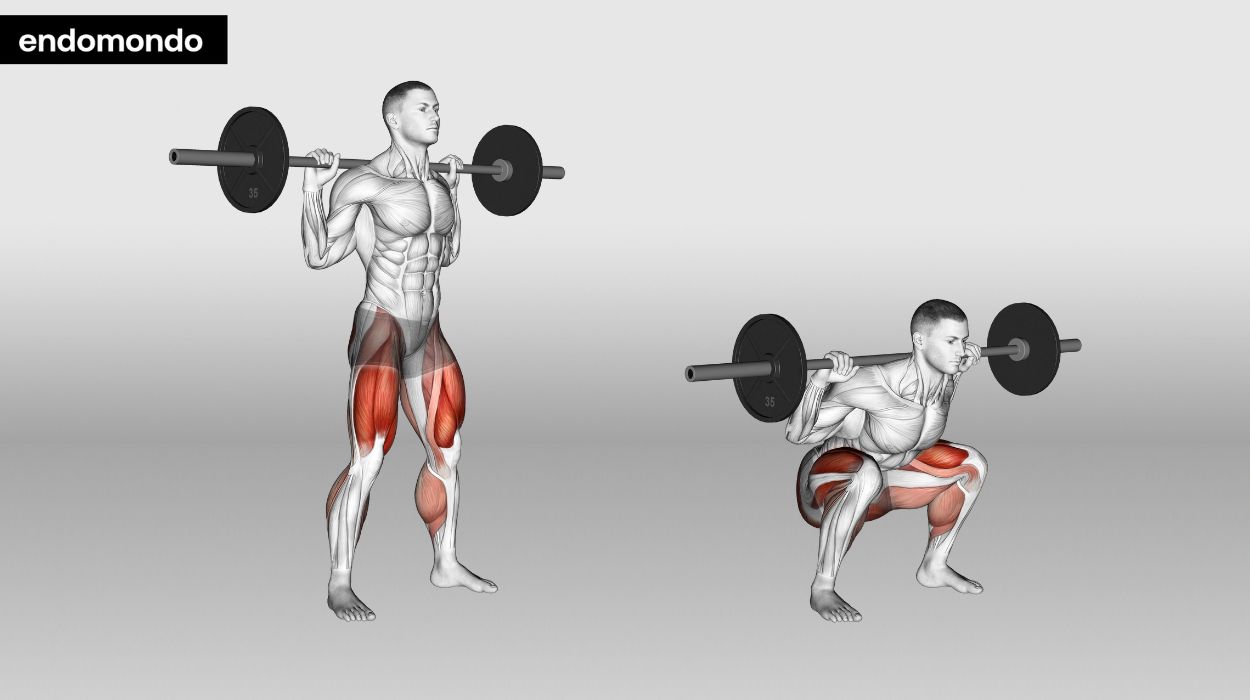
How to do:
- Stand with feet shoulder-width apart, barbell on the upper back, hands wider than shoulders, palms forward. You can also use two dumbbells for each hand, placing them on your shoulders as an alternative barbell.
- Take a deep breath, and brace your core muscles.
- Lower body by bending at hips and knees until thighs are parallel to the floor.
- Pause briefly, then drive through heels to stand up, exhaling.
- You can also squat with your body weight only.
Tips:
- Ensure proper form by keeping your chest up, back straight, and knees in line with your feet to prevent excessive forward lean or rounding of the back.
- Begin with an appropriate weight that allows you to maintain good form, and progressively increase the resistance as you become more comfortable with the movement.
- Engage your core and maintain a controlled descent and ascent, avoiding bouncing or jerking motions to protect your joints and maximize muscle engagement.
Optimal Sets and Reps: Three sets of 10-12 reps.
Weight Swing
Also known as the kettlebell swing, it is a full body workout for weight loss, but you can use a dumbbell as well.
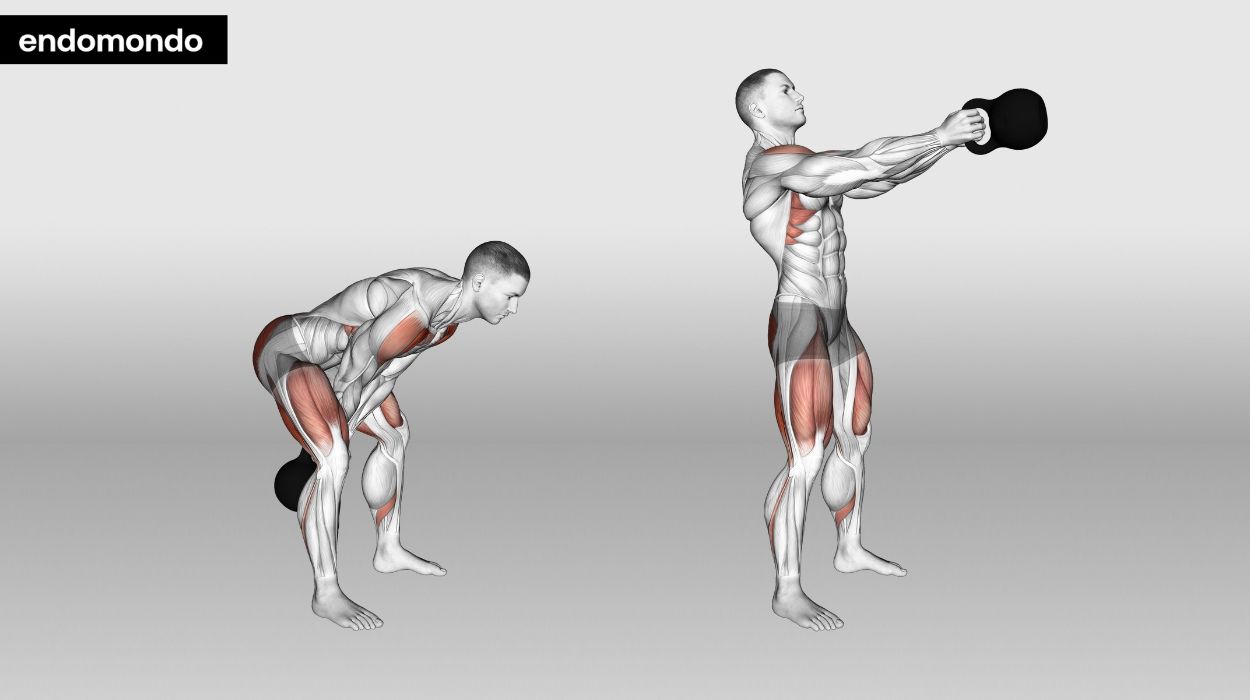
How to do:
- Stand with feet shoulder-width apart, weight on the ground in front of you. Hinge at the hips, grab the weight with both hands, and stand up explosively, swinging the weight to shoulder height.
- Swing the weight back between your legs while keeping your core and back engaged.
- Repeat for desired reps, using hip power.
Tips:
- Keep a strong and engaged core throughout the movement to provide stability and protect your lower back.
- Focus on a fluid and continuous motion, avoiding abrupt stops or jerky movements during the swings.
- Control your breathing, exhaling forcefully as you swing the weight up and inhaling during the downward phase to enhance power and coordination.
Optimal Sets and Reps: Three sets of 12-15 reps.
Wall Ball Shot
It is a dynamic and effective exercise that combines strength, accuracy, and endurance to challenge your fitness limits
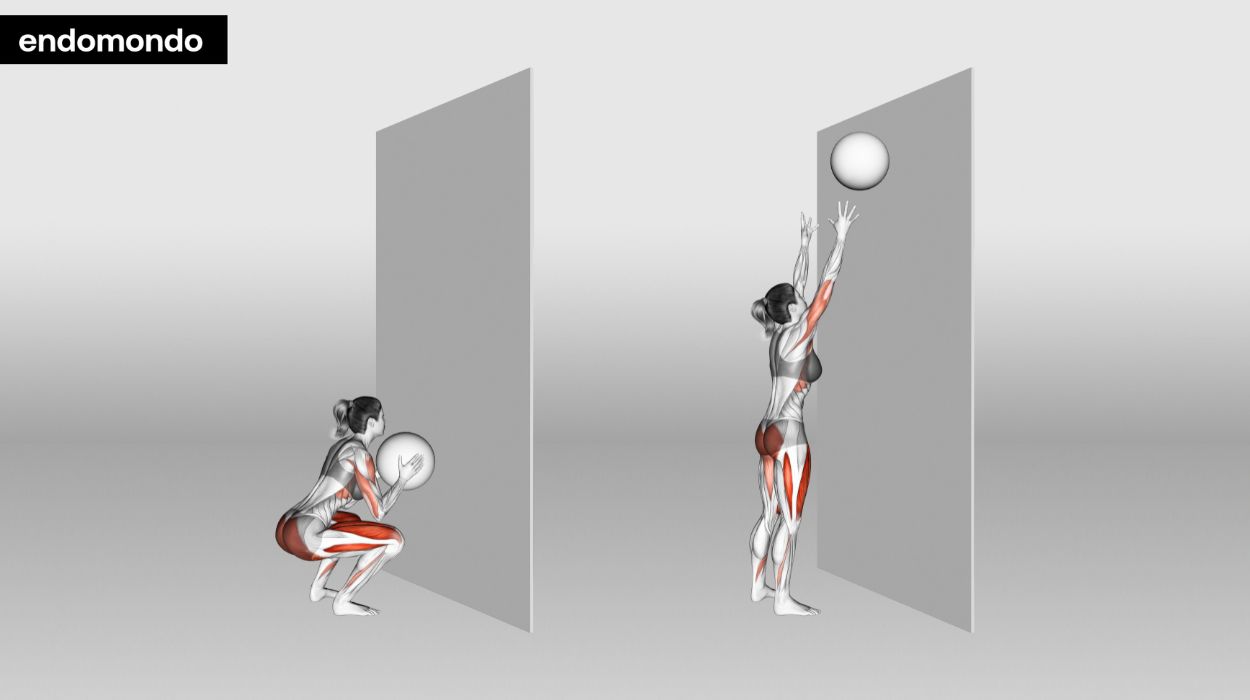
How to do:
- Begin by standing with your feet shoulder-width apart, facing a wall. Hold a weighted ball (medicine ball) at chest height with both hands.
- Squat down by bending at the hips and knees, keeping your weight on your heels and your chest up. Keep the medicine ball at your chest throughout the squat.
- Explosively stand up and simultaneously throw the ball up to hit a target on the wall, which is typically located nine to 10 feet above the ground. The target is usually marked with a piece of tape or a target ring.
- Catch the ball as it comes back down and immediately go into the next repetition. Try to maintain a consistent rhythm and pace.
Tips:
- Focus on a smooth and controlled motion throughout the exercise, avoiding jerky movements that can strain your shoulders or back.
- Choose an appropriate medicine ball weight that allows you to complete the reps with good form and maintain a consistent pace.
- Keep your eyes on the target on the wall to enhance accuracy and coordination during the throw.
Optimal Sets and Reps: Three to four sets of 10-15 reps.
Battle Ropes
Battle ropes are specially weighted ropes and a good exercise for both metabolic and strength training.
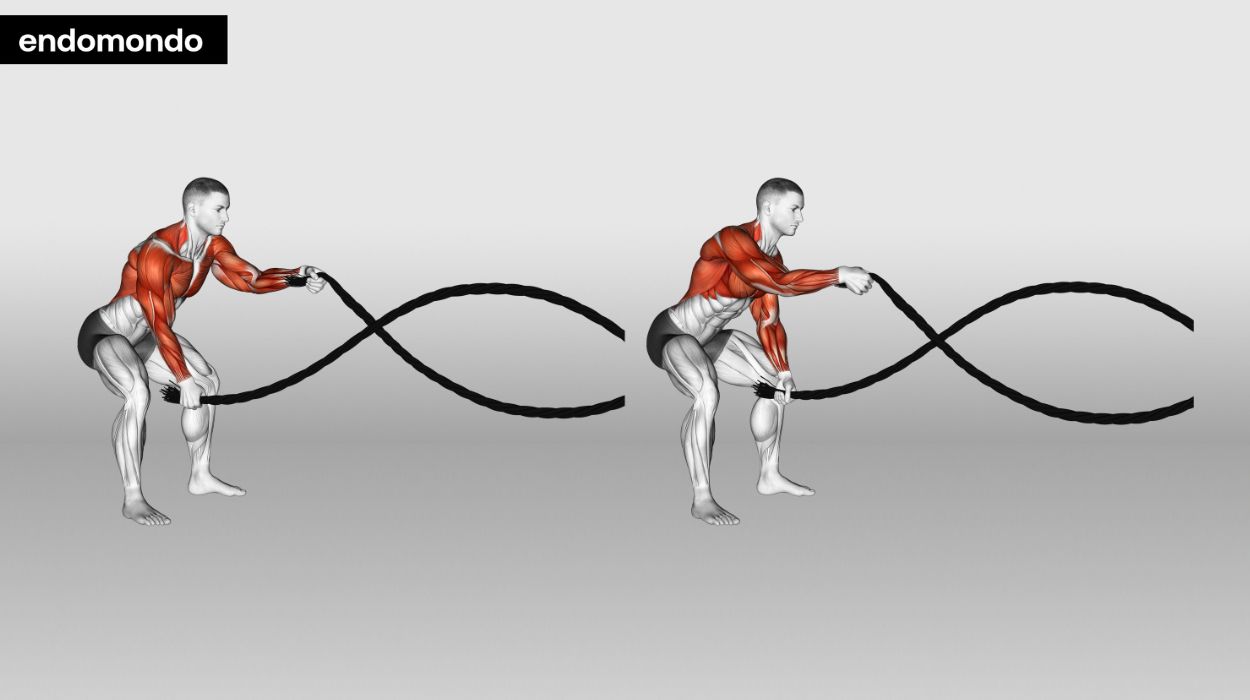
How to do:
- Stand with feet shoulder-width apart, holding one end of a battle rope in each hand.
- Raise both arms to shoulder height, creating a wave in the rope.
- Alternate between raising each arm up and down, creating a wave-like motion in the rope.
- Continue the wave motion for a desired amount of time or reps.
Tips:
- Maintain a stable stance and engage your core to protect your lower back during rope movements.
- Create fluid waves by using both arms simultaneously, generating power from your hips and shoulders.
- Vary your intensity and movements, including alternating waves, slams, or circles, to target different muscle groups and keep your workout engaging.
Optimal Sets and Reps: Three to four sets of 30-60 seconds.
How To Build A Weight Loss Workout Routine
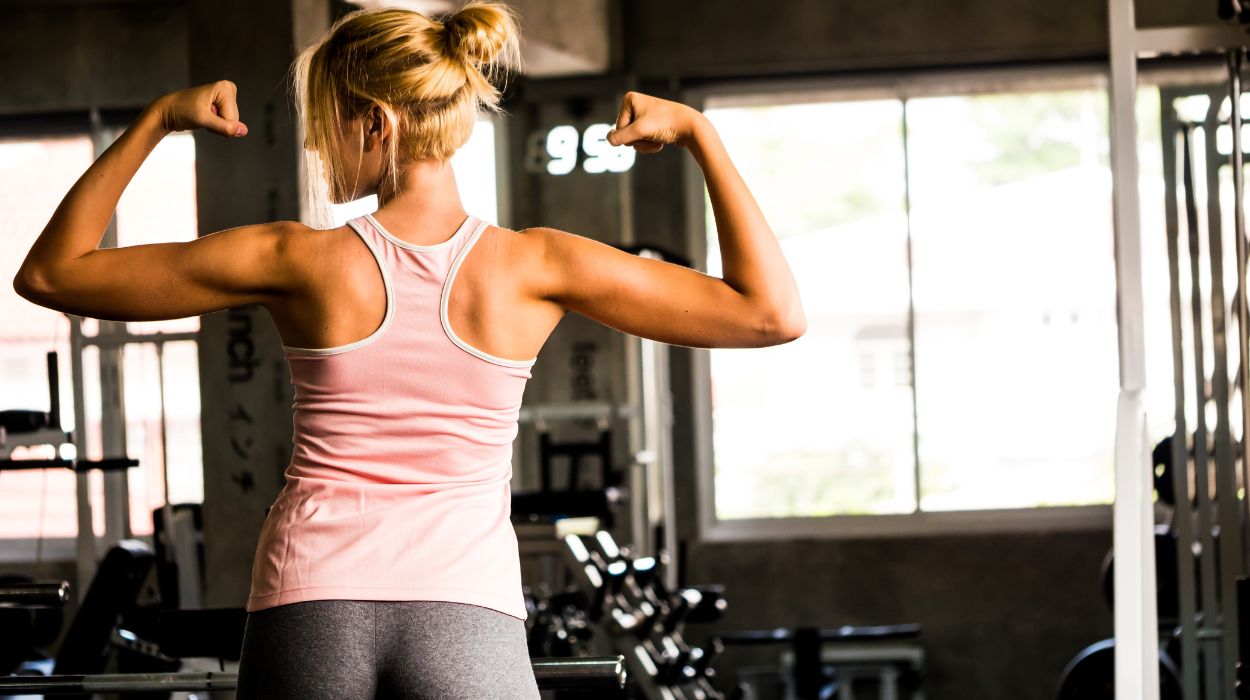
For example, a 30-minute weight loss workout can include both body weight and extra weight exercises we mentioned before. You can choose a total of four exercises. However, if you do both exercises, it is better to start with extra weight exercises for better performance. You can consider putting the more difficult workouts at the beginning of your exercise period to do them more efficiently with correct body forms.
Adding continuous mechanical loading and strength training to your exercise routine contributes to muscle production.[1]
The effects of exercises[2] mainly depend on the total volume and load that your muscles receive, the duration of the tension on the muscles, or the contraction speed and power.
Personalize Your Training
So; the full-body workout plan should include a variety of strength[3] and cardio[4] exercises. The main principles[3] of exercise can be changed and modulated during the workout plan depending on the desired muscle function to be supported.
A full body workout for weight loss for males and females may differ due to the baseline muscle mass and physiological differences. Workout plans for females generally include more repeats with fewer heavy weights. It was suggested that three to four sets per exercise be included in the workout for adult women, on two to four training days per week, according to the meta-analysis results.[5]
The repeat amount differs in weight exercises according to your main goal. Increasing your muscle mass and volume can reduce repeats but increase the weight you lift. But if your aim is losing weight, you can do 12-15 repeats for each exercise with comparatively lower weights.
Does Full Body Exercise Support Weight Loss?
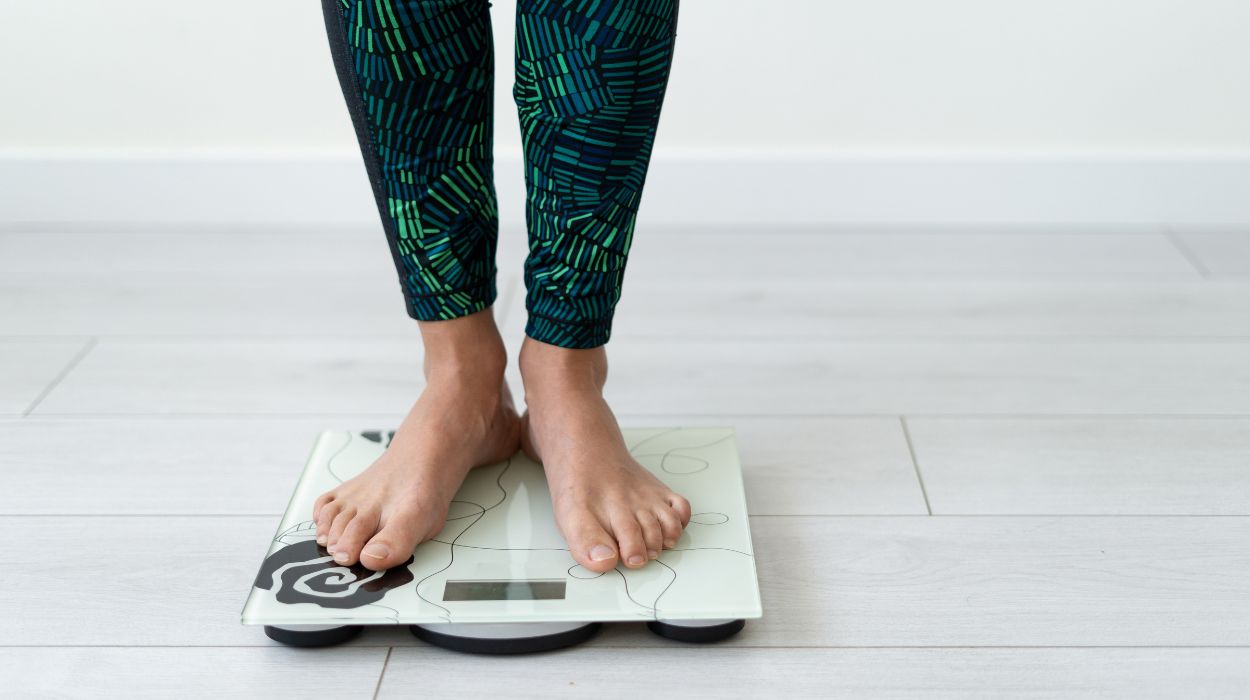
Yes, you can support with full body workout for weight loss besides your diet. During the workouts, you produce energy to do physical movements. And if you eat less than you expend, your body may produce this energy from your tissues, which are generally fat.
Another aspect of exercise, it helps to increase the muscle-to-fat ratio of the body. But why is it so important? Because the muscle mass of your body is one of the key factors that regulate your basal energy expenditure.[6]
Better Together: Moderate Intensity And High Intensity
To burn fat and increase lean body mass, it’s important to focus on a combination of cardio and strength training exercises that target different body areas.
Aerobic exercise[7] is a great way to burn calories and improve cardiovascular fitness, which is important for overall health and weight loss. Running, cycling, swimming, and dancing are all great forms of aerobic exercise that can help you lose weight and improve your fitness level. These are moderate exercises because you can perform them for long durations.
In addition to aerobic exercise, there are high-intensity movements that you can not perform for extended periods. A couple of minutes or even seconds are enough to be done. High-intensity exercises[8] are shown to be very effective in fat loss. You can do these exercises with your body weight or extra weight, such as using dumbbells.
Weight lifting[9] is another important component of a weight loss program. Lifting weights helps build upper body muscles and increases your body’s overall lean mass, which can help increase your metabolism and burn more calories. Incorporating weight lifting into your workout routine can burn fat and improve your body composition. It can help you achieve the lean, toned body you desire.
What Diet Should You Follow To Shed Pounds?
Your diet can change the effectiveness of your exercise. A diet including healthy, whole-food, high fiber, high vitamin, and mineral sources with moderately increased protein benefits energy expenditure due to food’s thermic effect.
Diet calories should be moderately decreased to stimulate fat loss, yet you want to remain in a calorie deficit overall. Consuming 500 calories less per day equates to approximately a 1-pound decrease in weight per week. On the other hand, we want to consume a particular level of protein which is an important factor in supporting muscles.
Protein
Daily protein intake[10] should be 1.4-2 grams/kilogram, at least for building muscle. It is well described in the studies that increased serum amino acid content, which is the building block of the protein structure, stimulates muscle protein synthesis.[11]
Carbohydrates
It should be accepted as a fact that adequate carbohydrate intake is essential for muscle preservation in addition to protein.
However, to lose body fat, it is essential to decrease carbohydrates because carbs are the main energy source that your body prefers to use. If there are enough carbs, your body doesn’t switch the energy source to body fat, and you can’t achieve fat tissue loss.
Fat
Fats are also an essential component of the body. They contribute to the production of many hormones and physiological activities in the metabolism; therefore, you need to keep healthy fat alternatives in your diet, such as olive oil, nuts, and avocados.
But just remember that fat sources provide dense energy and should be included in a limited amount of the diet.
The only foods you mainly remove from your diet are simple sugar sources, saturated or trans fats, and highly processed foods. These don’t benefit your body directly stimulate weight gain or contribute to other health problems.
The Takeaway
Incorporating a full body workout for weight loss that includes compound movements, cardio, and high-intensity training can effectively shed pounds and improve overall health. Committing healthy lifestyle changes is essential to achieve your weight loss goals.
You can talk first with your doctor and then a certified personal trainer to build your right exercise routine. Also, you can get help from a registered dietitian to follow a healthy and sustainable diet.
+ 11 sources
Health Canal avoids using tertiary references. We have strict sourcing guidelines and rely on peer-reviewed studies, academic researches from medical associations and institutions. To ensure the accuracy of articles in Health Canal, you can read more about the editorial process here
- Fyfe, J.J., Hamilton, D.L. and Daly, R.M. (2021). Minimal-Dose Resistance Training for Improving Muscle Mass, Strength, and Function: A Narrative Review of Current Evidence and Practical Considerations. Sports Medicine, [online] 52(3), pp.463–479. doi:https://doi.org/10.1007/s40279-021-01605-8.
- Schoenfeld, B.J., Ogborn, D. and Krieger, J.W. (2016). Effects of Resistance Training Frequency on Measures of Muscle Hypertrophy: A Systematic Review and Meta-Analysis. Sports Medicine, [online] 46(11), pp.1689–1697. doi:https://doi.org/10.1007/s40279-016-0543-8.
- Krzysztofik, M., Wilk, M., Wojdała, G. and Gołaś, A. (2019). Maximizing Muscle Hypertrophy: A Systematic Review of Advanced Resistance Training Techniques and Methods. International journal of environmental research and public health, [online] 16(24), p.E4897. doi:https://doi.org/10.3390/ijerph16244897.
- Wewege, M., van den Berg, R., Ward, R.E. and Keech, A. (2017). The effects of high-intensity interval training vs. moderate-intensity continuous training on body composition in overweight and obese adults: a systematic review and meta-analysis. Obesity Reviews, [online] 18(6), pp.635–646. doi:https://doi.org/10.1111/obr.12532.
- Hagstrom, A.D., Marshall, P.W., Halaki, M. and Hackett, D. (2019). The Effect of Resistance Training in Women on Dynamic Strength and Muscular Hypertrophy: A Systematic Review with Meta-analysis. Sports Medicine, [online] 50(6), pp.1075–1093. doi:https://doi.org/10.1007/s40279-019-01247-x.
- McNab, B.K. (2019). What determines the basal rate of metabolism? Journal of Experimental Biology. [online] doi:https://doi.org/10.1242/jeb.205591.
- Berge, J., Hjelmesæth, J., Hertel, J.K., Gjevestad, E., Småstuen, M.C., Johnson, L.K., Martins, C., Andersen, E., Helgerud, J. and Støren, Ø. (2021). Effect of Aerobic Exercise Intensity on Energy Expenditure and Weight Loss in Severe Obesity—A Randomized Controlled Trial. Obesity, [online] 29(2), pp.359–369. doi:https://doi.org/10.1002/oby.23078.
- Maillard, F., Pereira, B. and Boisseau, N. (2017). Effect of High-Intensity Interval Training on Total, Abdominal and Visceral Fat Mass: A Meta-Analysis. Sports Medicine, [online] 48(2), pp.269–288. doi:https://doi.org/10.1007/s40279-017-0807-y.
- Oppert, J., Bellicha, A., Baak, M.A., Battista, F., Beaulieu, K., Blundell, J.E., Carraça, E.V., Encantado, J., Ermolao, A., Pramono, A., Farpour‐Lambert, N., Woodward, E., Dicker, D. and Busetto, L. (2021). Exercise training in the management of overweight and obesity in adults: Synthesis of the evidence and recommendations from the European Association for the Study of Obesity Physical Activity Working Group. Obesity Reviews, [online] 22(S4). doi:https://doi.org/10.1111/obr.13273.
- Jäger, R., Kerksick, C.M., Campbell, B.I., Cribb, P.J., Wells, S.D., Skwiat, T.M., Purpura, M., Ziegenfuss, T.N., Ferrando, A.A., Arent, S.M., Smith-Ryan, A.E., Stout, J.R., Arciero, P.J., Ormsbee, M.J., Taylor, L.W., Wilborn, C.D., Kalman, D.S., Kreider, R.B., Willoughby, D.S. and Hoffman, J.R. (2017). International Society of Sports Nutrition Position Stand: protein and exercise. Journal of the International Society of Sports Nutrition, [online] 14(1). doi:https://doi.org/10.1186/s12970-017-0177-8.
- Pasiakos, S.M. (2012). Exercise and Amino Acid Anabolic Cell Signaling and the Regulation of Skeletal Muscle Mass. Nutrients, [online] 4(7), pp.740–758. doi:https://doi.org/10.3390/nu4070740.



